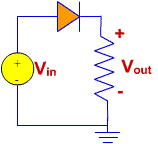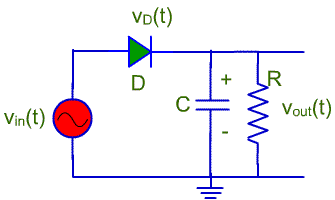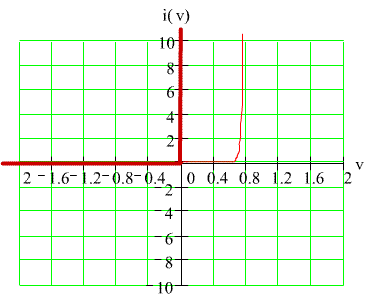| Using Diodes To Rectify Signals |
What is "Signal Rectification"?
Signal rectification is a process in which you process an AC (Alternating
Current) signal (often sinusoidal) to get a DC signal or a signal with a DC
component.
Why Rectify Signals
There are
many situations in which you want to "rectify" a signal. Here are some of
the most common situations.
-
In power supplies the AC supply
voltage (60 Hz in the U.S., from the wall plug) is converted to a constant DC
value to power electronic circuits that require a constant voltage to operate.
Examples include the following:
-
In signal systems, information
coded into the amplitude of a sinusoidal signal must be rectified to extract the
information. Examples include the following:
Signal rectification is an important concept and is
often used in a variety of systems.
Simple Signal Rectification
Here is a
simple signal rectifier. When the input voltage is positive, the output
voltage is approximately equal to the input.

Using A Capacitor In A Rectifier - Building A Peak Detector
Here is a
circuit.

Here is what happens in this circuit.
-
When the sinusoidal input is
increasing and the capacitor is uncharged, current flows through the diode to
charge the capacitor. (Remember, current is just charge flowing, so when
current flows through the diode into the capacitor, charge accumulates in the
capacitor.)
-
At some point in time, the input
voltage begins to decrease. At that point, the diode stops conducting and
the capacitor/resistor combination is effectively cut off from the rest of the
circuit and the capacitor begins to discharge through the resistor.
-
As the capacitor discharges,
eventually the input voltage gets to a point where it equals the capacitor
voltage, and the diode begins conducting again, charging the capacitor in the
process.
There are
some things to consider. The first point to consider is just how far the
voltage will droop from the peak until it begins to increase again. Just
past the peak the voltage across the capacitor will decrease for a short while.
What happens is that the input voltage (the sine wave) is decreasing but not
decreasing very quickly. (As you get further from the peak the voltage
begins to decrease more quickly.) When the input voltage is not decreasing
very quickly, the charge flowing out of the capacitor can flow through the
resistor, and there will still be current flowing through the diode. (Some
of the current flowing through the diode comes from charge on the capacitor, and
some flows through the diode.) However, sooner or later, the input voltage
gets to the point where it is decreasing faster than the capacitor voltage can
change. The limit on how fast the capacitor can discharge is determined by
the resistor. For a given voltage, Vout on the
capacitor, the current out of the capacitor is limited to Vout/R.
Since the capacitor current is CVoutd/dt, the rate of change
of capacitor voltage can be computed as dVout/dt = -Vout/(RC).
At that point
There are a few other points to note about this circuit.
-
The resistor in parallel with the
capacitor may well be the internal resistance of the capacitor.
-
The simulation above assumes that
the diode is an ideal diode. That's pictured below with the bold red
graph.

We can add a "bias" to the diode model to get closer to
reality. The voltage-current curve for a better model is shown below.
Click the button to see how closely the model comes to the v-i curve for a
"typical" diode.
If we incorporate that model into our simulation,
then the simulation is different.
You can see in the simulation that the output voltage
does not quite follow the input voltage - due to the threshold voltage in the
diode.
|

